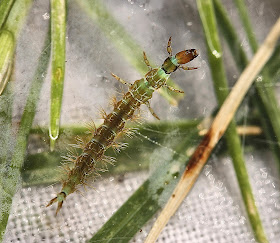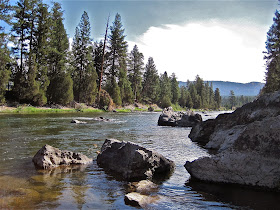It's always a pleasure for me to find EPT insects that Beaty notes as "rare" or "uncommon," or those that remain unidentified at this point in time. While they're always noted in separate entries, in this entry I thought I'd pull all of that data together. Beaty's comment is noted, and I've also cited the location at which the insect was found.
I. Mayflies (Ephemeroptera)
1. Small minnow mayfly,
Heterocloeon petersi. Found in the Rivanna River at Crofton. Beaty -- "Listed as 'vulnerable to extirpation' by Morse
et al. (1997)." I've only found one.
2. Small minnow mayfly,
Iswaeon anoka. The Rivanna River at Darden Towe Park (Charlottesville). Beaty -- "uncommon." I've only found one.
3. Flatheaded mayfly,
Rhithrogena sp., possibly
R. exilis. Buck Mt. Creek. Beaty -- if it's
exilis -- "Listed as 'vulnerable to extirpation' by Morse
et al. (1997)." I've only found one.
4. Spiny crawler mayfly,
Drunella walkeri. Doyles River and Buck Mt. Creek. Beaty -- "uncommon in the mountains." Seen a number of times.
5. Spiny crawler mayfly,
Serratella serrata. Doyles River. Beaty -- "relatively uncommon and collected during summer only." I've only found one.
6. Pronggilled mafyly,
Habrophlebia vibrans. Rapidan River. Beaty -- "uncommon." I've only found one.
7. Common burrower mayfly,
Ephemera guttalata. Small streams in Sugar Hollow. Beaty -- "uncommon." My friend and I have found this three times.
II. Stoneflies (Plecoptera)
1. Nemourid stonefly, genus
Soyedina. Small stream in Sugar Hollow. Beaty -- "relatively rare."
We've seen these twice.
2. Large winter stonefly,
Taenionema atlanticum. Small streams in Sugar Hollow, Entry Run, Rapidan River. Beaty -- "rarely collected." ??? We see a lot of them in the winter.
3. Common stonefly,
Agnetina capitata. Entry Run, Greene County. Beaty -- "Listed by NC Natural Heritage Program as Significantly Rare (2010)." I've only seen one.
4. Perlodid stonefly
Helopicus subvarians. Doyles River and Buck Mt. Creek. Beaty -- "relatively uncommon." I see a lot of them in the winter.
5. Perlodid stonefly,
Isogenoides hansoni. Rapidan River. Beaty -- "relatively rare." I think I've seen this four times.
6. Perlodid stonefly,
Isoperla similis. Rapidan River, small streams in Sugar Hollow. Beaty -- "relatively uncommon." I've seen them a number of times -- but not a lot.
7. Perlodid stonefly,
Isoperla orata. Rapidan River. Beaty -- "uncommon." I've seen a handful at the Rapidan; mostly late spring.
8. Perlodid stonefly,
Isoperla sp. Rapidan River, Doyles River, Buck Mt. Creek. Beaty -- "undescribed and unassociated larva" (personal communication). I've seen quite a few of them at the Rapidan River.
9. Perlodid stonefly,
Isoperla sp. Small streams in Sugar Hollow. Beaty -- "undescribed and unassociated larva" (personal communication). Very common in Sugar Hollow in winter and spring.
10. Perlodid stonefly,
Isoperla sp. Small streams in Sugar Hollow. Beaty -- "undescribed, unassociated larva" (personal communication). Only seen twice.
________________
III. Caddisflies (Trichoptera)
1. Freeliving caddisfly larva,
Rhyacophila glaberrima. Small stream in Sugar Hollow, Entry Run in Greene County. Beaty -- "relatively rare." Found twice.
2. Fingernet caddisfly larva, genus
Wormaldia. Small streams in Sugar Hollow. Beaty -- "uncommon." I've seen it twice.
3. Humpless case-maker,
Adicrophleps hitchcocki. Small stream in Sugar Hollow. NatureServe lists as "imperiled" in the state of Virginia." Found only once by my friend who lives in Sugar Hollow. The following photo was taken by her.
4. Northern case-maker,
Pycnopsyche gentilis. Small streams in Sugar Hollow. Beaty -- "relatively uncommon." ??? We find them quite often in the winter and spring, some in three-sided cases of leaves, some in cases of pebbles, and some in "mixed media" cases.
5. Northern case-maker,
Pseudostenophalyx sparsus. Spring seep in Sugar Hollow. Beaty -- "rare." Found only once by my friend who lives in Sugar Hollow. The following photo was taken by her.
6. Weighted case-maker,
Goera fuscula. Entry Run in Greene County. Beaty -- "rare." I've seen them twice.
7. Uenoid caddisfly larva,
Neophylax fuscus. South River, Buck Mt. Creek, Moormans River. Beaty -- "relatively rare." Found three times.
8. Strong case-maker,
Psilotreta frontalis. Small, temporary stream in Doyles River Valley. Beaty -- "less than 60 BAU records." Only seen once.
________________
When the weather improves, I'll be out looking for more nymphs and larvae to add to this list.








































































